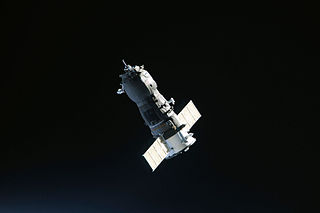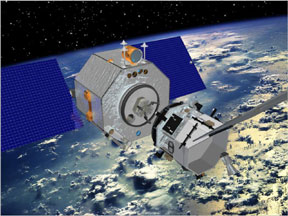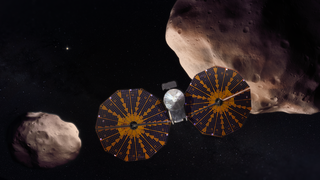Related Research Articles

The Science, Technology and Innovation (STI) sector is guided by two primary institutions, the National Commission on Science and Technology (NCST) and the Scientific Research Council (SRC). Both are under the direction of the Ministry of Science, Energy, and Technology.

A spacecraft is a vehicle that is designed to fly in outer space and operate there. Spacecraft are used for a variety of purposes, including communications, Earth observation, meteorology, navigation, space colonization, planetary exploration, and transportation of humans and cargo. All spacecraft except single-stage-to-orbit vehicles cannot get into space on their own, and require a launch vehicle.

The Space Shuttle program was the fourth human spaceflight program carried out by the U.S. National Aeronautics and Space Administration (NASA), which accomplished routine transportation for Earth-to-orbit crew and cargo from 1981 to 2011. Its official name, Space Transportation System (STS), was taken from a 1969 plan for a system of reusable spacecraft of which it was the only item funded for development. It flew 135 missions and carried 355 astronauts from 16 countries, many on multiple trips.

The Apollo Lunar Module, originally designated the Lunar Excursion Module (LEM), was the lunar lander spacecraft that was flown between lunar orbit and the Moon's surface during the United States' Apollo program. It was the first crewed spacecraft to operate exclusively in the airless vacuum of space, and remains the only crewed vehicle to land anywhere beyond Earth.

Uncrewed spacecraft or robotic spacecraft are spacecraft without people on board. Uncrewed spacecraft may have varying levels of autonomy from human input; they may be remote controlled, remote guided or autonomous: they have a pre-programmed list of operations, which they will execute unless otherwise instructed. A robotic spacecraft for scientific measurements is often called a space probe or space observatory.

The NASA Deep Space Network (DSN) is a worldwide network of American spacecraft communication ground segment facilities, located in the United States (California), Spain (Madrid), and Australia (Canberra), that supports NASA's interplanetary spacecraft missions. It also performs radio and radar astronomy observations for the exploration of the Solar System and the universe, and supports selected Earth-orbiting missions. DSN is part of the NASA Jet Propulsion Laboratory (JPL).
Ball Aerospace & Technologies Corp. or just Ball Aerospace is an American manufacturer of spacecraft, components and instruments for national defense, civil space and commercial space applications. The company is a wholly owned subsidiary of Ball Corporation, with primary offices in Boulder, Colorado, and facilities in Broomfield and Westminster in Colorado, with smaller offices in New Mexico, Ohio, northern Virginia, Missouri and Maryland.

STS-95 was a Space Shuttle mission launched from Kennedy Space Center, Florida on 29 October 1998, using the orbiter Discovery. It was the 25th flight of Discovery and the 92nd mission flown since the start of the Space Shuttle program in April 1981. It was a highly publicized mission due to former Project Mercury astronaut and United States Senator John H. Glenn Jr.'s return to space for his second space flight. At age 77, Glenn became the oldest person to go into space, a record that remained unbroken for 23 years until 82-year-old Wally Funk flew on a suborbital flight on Blue Origin NS-16, launching on 20 July 2021, which in turn was broken by William Shatner at age 90 on 13 October 2021. Glenn, however, remains the oldest person to reach Earth orbit. This mission is also noted for inaugurating ATSC HDTV broadcasting in the U.S., with live coast-to-coast coverage of the launch. In another first, Pedro Duque became the first Spaniard in space.
Orbital Sciences Corporation was an American company specializing in the design, manufacture, and launch of small- and medium- class space and launch vehicle systems for commercial, military and other government customers. In 2014, Orbital merged with Alliant Techsystems to create a new company called Orbital ATK, Inc., which in turn was purchased by Northrop Grumman in 2018. The remnants of the former Orbital Sciences Corporation became a subsidiary of Northrop Grumman, known as Northrop Grumman Space Systems.

Dream Chaser is an American reusable lifting-body spaceplane being developed by Sierra Space. Originally intended as a crewed vehicle, the Dream Chaser Space System is set to be produced after the cargo variant, Dream Chaser Cargo System, is operational. The crewed variant is planned to carry up to seven people and cargo to and from low Earth orbit.

Orbital Express was a space mission managed by the United States Defense Advanced Research Projects Agency (DARPA) and a team led by engineers at NASA's Marshall Space Flight Center (MSFC). The Orbital Express program was aimed at developing "a safe and cost-effective approach to autonomously service satellites in orbit". The system consisted of two spacecraft: the ASTRO servicing satellite, and a prototype modular next-generation serviceable satellite; NEXTSat. The mission launched from Cape Canaveral Air Force Station on 8 March 2007, aboard an Atlas V expendable launch vehicle. The launch was part of the United States Air Force Space Test Program STP-1 mission.
Jamaican Americans are an ethnic group of Caribbean Americans who have full or partial Jamaican ancestry. The largest proportions of Jamaican Americans live in South Florida and New York City, both of which have been home to large Jamaican communities since the 1950s and 60s. There are also communities of Jamaican Americans residing in Connecticut, Georgia, New Jersey, Pennsylvania, Maryland, Massachusetts, and California.

Grapple fixtures are used on spacecraft or other objects to provide a secure connection for a robotic arm.

The National Aeronautics and Space Administration is an independent agency of the U.S. federal government responsible for the civil space program, aeronautics research, and space research. Established in 1958, NASA succeeded the National Advisory Committee for Aeronautics (NACA) to give the U.S. space development effort a distinctly civilian orientation, emphasizing peaceful applications in space science. NASA has since led most American space exploration, including Project Mercury, Project Gemini, the 1968–1972 Apollo Moon landing missions, the Skylab space station, and the Space Shuttle. NASA currently supports the International Space Station and oversees the development of the Orion spacecraft and the Space Launch System for the crewed lunar Artemis program, the Commercial Crew spacecraft, and the planned Lunar Gateway space station.
An orbital replacement unit or orbital replaceable unit is a modular component of spacecraft that can be replaced upon failure either by robot or by extravehicular activity. The Hubble Space Telescope (HST) was designed with 70 such parts, including scientific instruments and limited-life items such as batteries.

The Near-Earth Asteroid Scout was a mission by NASA to develop a controllable low-cost CubeSat solar sail spacecraft capable of encountering near-Earth asteroids (NEA). NEA Scout was one of ten CubeSats launched into a heliocentric orbit on Artemis 1, the maiden flight of the Space Launch System, on 16 November 2022.

Lucy is a NASA space probe on a twelve-year journey to eight different asteroids, visiting two main belt asteroids as well as six Jupiter trojans, asteroids which share Jupiter's orbit around the Sun, orbiting either ahead of or behind the planet. All target encounters will be flyby encounters. The Lucy spacecraft is the centerpiece of a US$981 million mission.

The spacecraft bus is a carbon fibre box that houses systems of the telescope and so is the primary support element of the James Webb Space Telescope, launched on 25 December 2021. It hosts a multitude of computing, communication, propulsion, and structural components. The other three elements of the JWST are the Optical Telescope Element (OTE), the Integrated Science Instrument Module (ISIM) and the sunshield. Region 3 of ISIM is also inside the spacecraft bus. Region 3 includes the ISIM Command and Data Handling subsystem and the Mid-Infrared Instrument (MIRI) cryocooler.

Double Asteroid Redirection Test (DART) was a NASA space mission aimed at testing a method of planetary defense against near-Earth objects (NEOs). It was designed to assess how much a spacecraft impact deflects an asteroid through its transfer of momentum when hitting the asteroid head-on. The selected target asteroid, Dimorphos, is a minor-planet moon of the asteroid Didymos; neither asteroid poses an impact threat to Earth. Launched on 24 November 2021, the DART spacecraft successfully collided with Dimorphos on 26 September 2022 at 23:14 UTC about 11 million kilometers from Earth. The collision shortened Dimorphos' orbit by 32 minutes, greatly in excess of the pre-defined success threshold of 73 seconds. DART's success in deflecting Dimorphos was due to the momentum transfer associated with the recoil of the ejected debris, which was substantially larger than that caused by the impact itself.
References
- 1 2 "Icons". 2017. Retrieved 6 May 2022.
- ↑ "Prof Lalor's Order of Merit well deserved". 8 August 2019. Archived from the original on 3 September 2021. Retrieved 6 May 2022.
- ↑ "US Patent for Protective enclosure for use transporting orbital replacement units (orus) within a space craft Patent (Patent # 6,863,190 issued March 8, 2005) – Justia Patents Search". patents.justia.com. 20 September 2002. Retrieved 6 May 2022.
- ↑ "Robert Rashford Biography Webb Telescope/NASA". jwst.nasa.gov. Retrieved 6 May 2022.